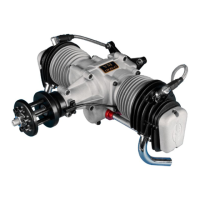16
Appendix Basics of petrol engines
Engine cooling
To cool the engine, it is not necessary to cut big holes into the cowling, but you have to
ensure, that the air ows around the cylinders before it leaves the cowl. Do not forget: The
air nds the way with the least resistance, unfortunately this is mostly not the way through
the cooling ns. The best material to make baes from is balsa, it can be positioned close to
the engine, as it will grind in, it will not cause interference and it is not sensitive to vibrations.
Air, which ows in a distance of more than a few millimeters from the cooling ns has
no eect on the cooling of the engine! In other words: The worst cooling is achieved by
a cowling with a huge volume, a big intake and no attempt to force the air through the
cooling ns of your engine.
Example of installation, the VM 170 B2-4T in a EMW 3m Pitts
For ight tests, I installed one of the prototypes of the VM 170 B2-4T into a 3 meter Pitts
from Weiershäuer. The model has a take o weight of 22,5 kg, this is with gasoline (for about
20 minutes of aerobatics) and 750 ml Smoke oil. The performance of the VM 170 B2-4T is
convincing and permits vertical acceleration with ease.

